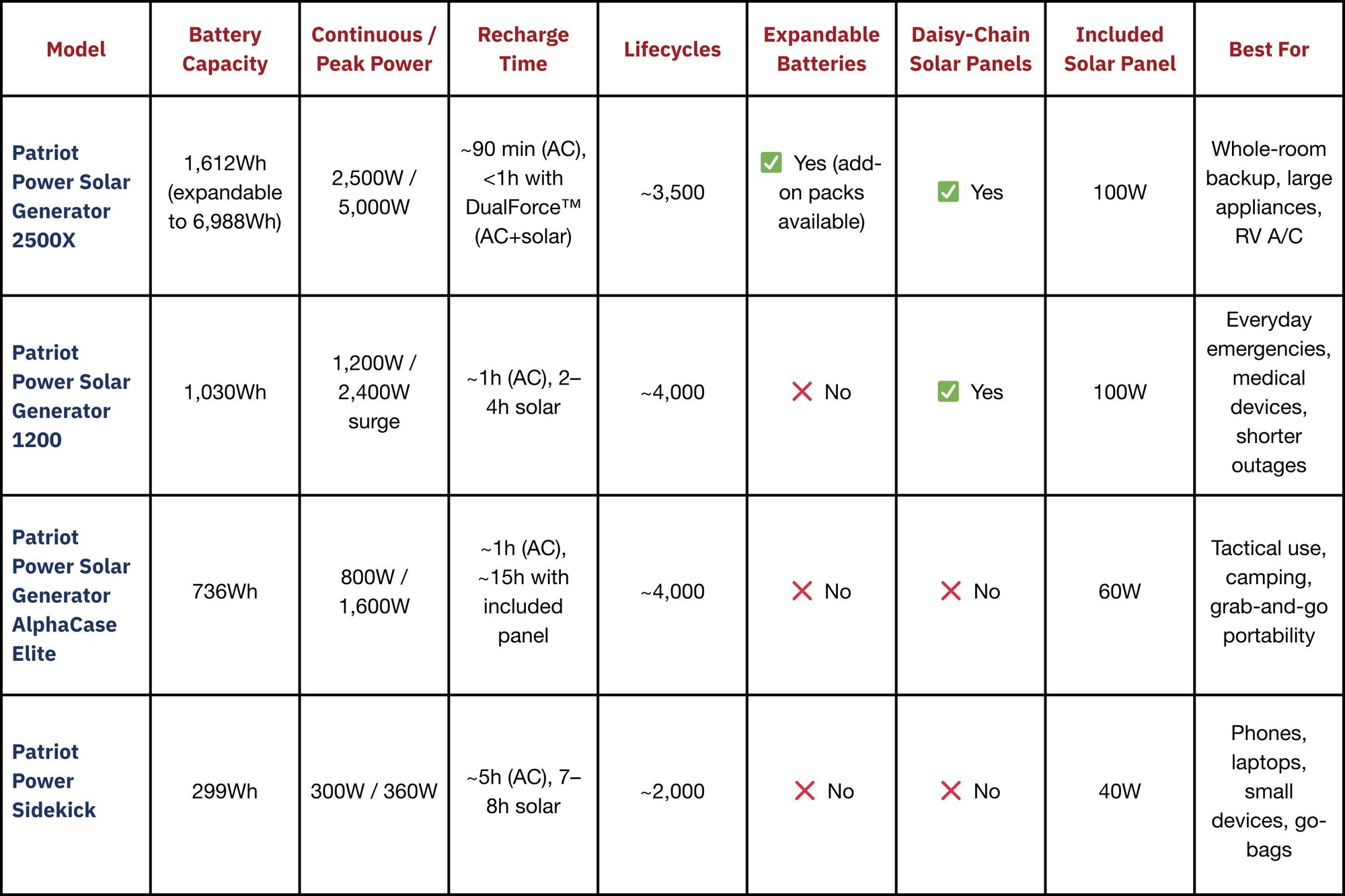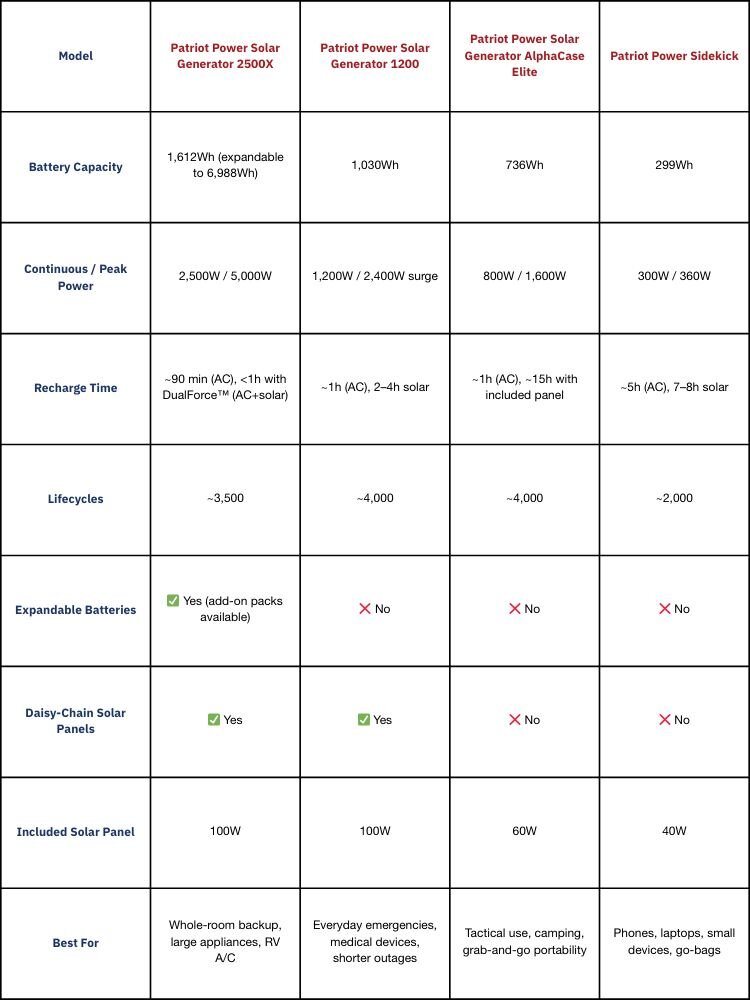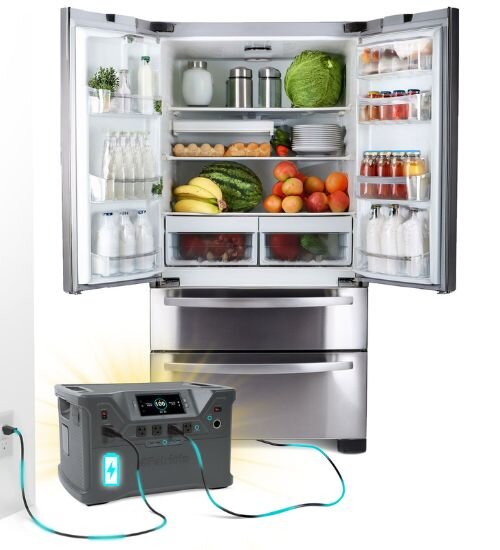Your Solar Generator Cheat Sheet

Quick Answer: Which Patriot Power Solar Generator Is Right for You?
- For whole-room backup & big appliances: The Patriot Power Solar Generator 2500X delivers 2,500W continuous power, 1,612Wh capacity, and recharges in about 90 minutes. It even supports expandable batteries and daisy chaining solar panels for faster charging. Comes with a 100W folding solar panel.
- For everyday essentials & easy portability: The Patriot Power Solar Generator 1200 provides 1,200W continuous output with 1,030Wh storage. Lightweight at 28 lbs, it recharges in about 1 hour (AC) and can daisy chain solar panels. Comes with a 100W lightweight solar panel.
- For grab-and-go, tactical use: The Patriot Power Solar Generator AlphaCase Elite is a rugged briefcase-style unit with 800W continuous / 1,600W peak output and 736Wh capacity. Packs up with its 60W lightweight solar panel inside for quick deployment.
- For ultra-portable power on the go: The Patriot Power Sidekick Solar Generator is compact and under 10 lbs. It provides 300W continuous output, 299Wh capacity, and recharges in about 5 hours (AC) or 7-8 hours solar. Includes a 40W folding solar panel.
Choosing the Right Solar Generator: What Sets Each Model Apart
When the grid goes down, you don’t have time to guess. You want safe, indoor-ready power that keeps your food cold, your CPAP running, and your family connected. Solar generators do exactly that quietly, without gas or fumes. Below, we break down four popular options so you can pick with confidence: the Patriot Power Solar Generator 2500X, Patriot Power Solar Generator 1200, Patriot Power Solar Generator AlphaCase Elite, and the Patriot Power Sidekick.
Before we dive in, remember: the key to choosing the right solar generator is knowing your life and your must-have essentials. Start by asking: what do I absolutely need powered during an outage. Food storage, medical devices, lights, communication? Once you know your non-negotiables, the right generator choice becomes clear.
Patriot Power Solar Generator 2500X: The Heavy-Duty Protector

What sets the Patriot Power Solar Generator 2500X apart is sheer power and speed. With 2,500W continuous output (5,000W surge), it’s strong enough to handle multiple full-size appliances at once, even energy-hungry machines like sump pumps and washing machines. Thanks to DualForce™ recharging, it can recover to 70% in under an hour when using AC + solar together.
But here’s where it really stands out: the 2500X can grow with you. You can connect expandable battery packs (up to 6,988Wh total) for dramatically extended runtime. Plus, the included 100W solar panel can be daisy chained with additional panels, giving you faster solar recharging and more independence during long-term outages.
Why it’s valuable: Families who’ve lost food, water, or heat in past blackouts know you need muscle to keep going. The 2500X is like having a portable power plant and it can expand as your needs grow.
Best for: Whole-room backup, big appliances, RVs, longer blackouts.
Patriot Power Solar Generator 1200: The Everyday Lifeline

The Patriot Power Solar Generator 1200 hits the “Goldilocks zone” for most households. At 1,200W output and just 28 pounds, it’s light enough to carry but powerful enough to run a fridge, CPAP, and lights simultaneously. Built with a LiFePO4 battery rated for ~4,000 cycles, it’s designed to last over a decade with regular use.
It also comes with a 100W lightweight solar panel that can be daisy chained with others, so you can expand your solar input and recharge more quickly when the sun is shining.
Why it’s valuable: This is the solar generator most families will actually use. It’s not overkill, it’s not undersized. It’s the reliable, affordable everyday insurance policy that you can trust when you need it most. It was even called a "game changer" by DIY Life Tech.
Best for: Everyday emergencies, medical devices, short-to-moderate outages with easy portability.
Patriot Power Solar Generator AlphaCase Elite: The Tactical Briefcase

The AlphaCase Elite is about speed and discretion. Designed in a slim, rugged briefcase form factor, everything (battery, inverter, cables, even the included 60W solar panel) fits inside. You can grab it and move in seconds. At 800W continuous / 1,600W surge, it won’t run a house, but it will quietly keep critical devices alive when you’re on the move.
Why it’s valuable: Emergencies don’t always happen at home. The AlphaCase Elite is perfect for road trips, field kits, or anyone who values compact security. It’s a generator you can tuck away until the moment you need it, then carry with one hand.
Best for: Discreet portability, field use, camping, vehicle kits, apartment dwellers who want compact gear.
Patriot Power Sidekick: The Mini Workhorse

The Sidekick is the smallest of the lineup but don’t underestimate it. With 300W continuous / 360W surge and 299Wh capacity, it’s built for phones, laptops, radios, flashlights, and even a mini-fridge for a few hours. It weighs less than 10 lbs and comes with a 40W folding solar panel that fits in a backpack.
Why it’s valuable: Power outages aren’t always catastrophic. Sometimes you just need to stay connected. The Sidekick is your everyday lifeline. Toss it in your car, keep one in your closet, or add it to your go-bag. It’s the most affordable and portable way to keep communication lines open when the lights go out.
Best for: Go-bags, cars, quick comms, storm kits, mini-fridges for short stints.
Quick Generator Comparison Chart


3 Steps to Picking the Right Solar Generator for You

Choosing the right solar generator isn’t about the biggest battery or the most watts. It’s about what fits your life. Every family has different priorities, whether that’s peace of mind for medical needs, keeping food cold, or simply staying connected. By focusing on a few key considerations, you can quickly narrow in on the solar generator model that gives you confidence without overcomplicating your plan.
1. Decide on Your Must-Have Essentials
Start by asking: What do I absolutely need to keep running if the power goes out? For some families, it’s food storage and medical devices. For others, it’s staying connected with lights, phones, and the internet. Your answer determines the size of generator you’ll need.
2. Balance Portability vs. Power
Think about where and how you’ll use your solar generator. Do you want something you can move around the house or take camping, or a unit that’s designed to stay put and cover larger loads? Striking the right balance between portability and power makes sure you don’t under - or over- buy.
3. Plan for Recharging
A solar generator is only as reliable as its recharging strategy. Consider how much sun you typically get, where you’ll place your panels, and whether you might need faster recharging through daisy chaining multiple panels. Planning your recharge ensures your generator keeps going as long as the outage does.
Expert Tips for Using Your Solar Generator
Having a solar generator in your emergency plan is only half the battle. Using it wisely is what makes the difference. Here are our top tips and the most common mistakes to avoid so you get the most out of your Patriot Power solar generator.
✅ Helpful Tips
- Prioritize your essentials. Decide which devices are must-haves during a blackout (fridge, CPAP, lights, phone). Run those first, then add extras if capacity allows.
- Use in cycles. Don’t keep every appliance plugged in nonstop. For example, run your fridge until it cools, then unplug and cycle your CPAP or lights. This stretches battery life and keeps essentials running longer.
- Stay topped off. Keep your generator fully charged on AC when the grid is up. That way, you start every outage with a full battery and can use solar to extend your runtime.
- Take advantage of daisy chaining. With the 2500X and 1200, connect multiple solar panels to recharge faster in daylight. More panels = more power independence during extended outages.
- Expand if you need to. If you’re running multiple large appliances, consider adding expandable batteries to the 2500X. This multiplies your storage and runtime for long blackouts or off-grid living.
- Protect from the elements. These units are portable but not waterproof. Use them indoors, under cover, or in your RV. Keep panels angled toward the sun, but generators protected from rain.
- Store smart. For long-term storage, charge to about 80% and top off every few months. This maximizes battery lifespan and keeps your generator ready when you need it.
- Upgrade your lighting. Switching to LED bulbs dramatically reduces power draw, meaning your generator can run lights for days instead of hours.
- Know your numbers. Wattage matters. Before the lights go out, check the labels on your fridge, CPAP, or tools. This ensures you pick the right generator size and don’t overload your unit.
❌ Mistakes to Avoid
- Waiting for the outage to prepare. Don’t leave your generator in the box. Charge it, test it, and know how it works ahead of time.
- Overloading. Every unit has limits (2500W for the 2500X, 1200W for the 1200, etc.). Plugging in too much at once can trip the system.
- Bad solar setup. Panels lying flat or in shade won’t deliver. Angle them toward the sun and keep them clean for maximum efficiency.
- Neglecting storage care. Storing your generator drained or in extreme temperatures shortens its life. Treat it like an insurance policy: ready, reliable, maintained.
- Expecting whole-house coverage. Solar generators are for critical appliances and devices, not an entire home at once. Use them strategically and expand (with the 2500X) if your needs are bigger.
People Also Ask: Solar Generator FAQs
A solar generator stores energy in a battery, then converts it to household power through an inverter. You can recharge it using solar panels, a wall outlet, or even a car. They’re safe indoors, quiet, and ideal for keeping lights, fridges, and medical devices running during outages. Learn more about how solar power works here.
Setting up your solar generator is easier than you might think. Just follow these simple steps:

1. Unfold & set up solar panel in sunlight

2. Plug the panel into the generator

3. Plug in & power your devices
Yes. Solar generators produce no fumes or carbon monoxide, unlike gas units. They’re completely safe to operate indoors, making them perfect for running refrigerators, CPAP machines, and electronics during a blackout without worrying about toxic gases or dangerous fuel storage.
Yes. Larger models like the Patriot Power 2500X and 1200 can run a full-size fridge for many hours, especially when paired with solar panels for recharging. Compact models like the AlphaCase Elite and Sidekick can run mini-fridges or cycle medium appliances for shorter periods.
Sadly, the #1 mistake that we see in blackouts is people wasting precious power — on their fridge! Fact is, most modern-day refrigerators don’t need continuous power to keep cold… they cycle on and off. Here are a couple tips for “smart cycling” your fridge.
- Listen to your fridge. When you hear it “kick on” and start humming, that’s the sound of a compressor cycle cooling things down. When you hear it stop humming, you can “pause” supplying power.
- Recharge during downtime. Between compressor cycles, recharge your generator with the solar panel in direct sun.
- Conserve. If possible, fill your fridge with water bottles before the blackout. A full fridge maintains temperature better. And for Pete’s sake, keep the door closed!
- Location matters. Keep your fridge in a cooler area like a basement or a kitchen. Avoid direct sun. A cool room is less work for the compressor, so it uses less energy.
Solar panels still generate power in cloudy or indirect light, but charging will be slower. Most owners keep their generator topped up on wall power, then use solar during the day to extend runtime in emergencies, even with limited sunlight.
The 2500X delivers 2,500W output and supports expandable batteries, making it ideal for powering multiple large appliances. The 1200 provides 1,200W, weighs less, and is easier to carry. Both include 100W solar panels and allow daisy chaining for faster solar recharging.
Sure can. The 2500X is built with “Expansion Pack” ports, so you can snap on up to four extra expansion battery packs at the same time. No tools, just plug-and-play .
Each pack piles on more stored power. With all four connected, capacity jumps from 1,612 Wh to about 6,988 Wh, giving you roughly four times the run-time for your fridge, lights, or medical gear .
Bonus: Those packs can double as “mini generators” you can tote around the house for small jobs . So, if you need longer backup or power in two places at once, adding batteries is the easy fix.
The 1200, AlphaCase Elite, and Sidekick do not support expansion but still deliver long battery life with their built-in systems.
Recharge speed varies by model and method:
- 2500X: ~90 minutes (AC), under 1 hour (AC + solar), 8–10 hours on one solar panel (faster if daisy-chained).
- 1200: ~1 hour (AC), 7–9 hours solar (faster with daisy chain).
- AlphaCase Elite: ~1 hour (AC), ~15 hours solar.
- Sidekick: ~5 hours (AC), 7–8 hours solar.
- 2500X: 100W folding panel.
- 1200: 100W lightweight panel.
- AlphaCase Elite: 60W lightweight panel (stores inside the case).
- Sidekick: 40W folding panel.
- 2500X: Full fridge, sump pump, washer, RV A/C, dishwasher.
- 1200: Fridge, CPAP, lights, TV, small tools.
- AlphaCase Elite: CPAP, TV, mini-fridge, small tools, up to 800W continuous.
- Sidekick: Phones, laptops, radios, lights, mini-fridge for short periods.
- 2500X: ~3,500 lifecycles.
- 1200: ~4,000 lifecycles.
- AlphaCase Elite: ~4,000 lifecycles.
- Sidekick: ~2,000 lifecycles. (One cycle = full charge + discharge. Occasional use typically stretches lifespan over a decade.)
The Patriot Power 2500X and 1200 both allow daisy chaining multiple solar panels for much faster recharging in the sun.
Daisy chaining just means connecting more than one solar panel together so they work as a team. You plug the first panel into your generator, then connect the next panel to the first one, and so on. This way, you can collect more power without needing extra ports on your generator. You can hook up to 4 panels this way for faster charging.
The AlphaCase Elite and Sidekick do not support daisy chaining and are limited to their included panels.
All models are portable (a huge advantage over other generators). The Sidekick is the lightest at under 10 lbs and ideal for phones, laptops, and small electronics. The AlphaCase Elite weighs about 24 lbs and offers 800W in a discreet briefcase design. The 1200 (28 lbs) and 2500X (48 lbs) are heavier but more powerful.
Yes. Patriot Power generators are designed to stay plugged in and topped off so they’re always ready. Built-in battery management prevents overcharging, making it safe to leave them connected until you need them.
Ask yourself: What do I absolutely need to power during an outage?
- Multiple big appliances → 2500X
- Everyday essentials like fridge + CPAP → 1200
- Discreet, portable briefcase-style → AlphaCase Elite
- Lightweight backup for phones + laptops → Sidekick
Yes, you can run devices while the generator is charging from solar or AC. This is called "pass-through" charging.
Pass-through charging means your generator can keep your devices running during an outage, even while it’s plugged in and charging. Once the battery is full, it sends power straight from the wall to your stuff, without using the battery. That helps your battery last longer.
Pass-through charging is a big deal for things like fridges and medical devices. You don’t have to do anything during a blackout. The generator just takes over.

Solar generators are virtually silent. The only sound you may hear is a small cooling fan during heavy use. Compared to noisy gas generators, they’re ideal for indoor use, apartments, or nighttime outages.
Yes. Cold temperatures don’t stop them from working, though batteries perform best when kept above freezing. Panels also produce power in winter sun, sometimes even more efficiently in cooler air.
Think of watt-hours as “how much work” your power source can do over time.
- Find the watts. Look on the label of the gadget or add up the volts and amps (Volts × Amps = Watts).
- Pick the time. How long will you run it? Write that in hours.
- Multiply. Watts × Hours = Watt-hours.
Example:
A 50-watt radio playing for 4 hours: 50 W × 4 hr = 200 Wh.
That’s it. No fancy math. Just volts, amps, or watts, then a quick times-table.
To store your solar generator the right way:
- Keep it in a cool, dry place away from direct sunlight, moisture, or extreme heat.
- Charge it to about 60–80% before long-term storage. Not full, not empty.
- Recharge it every 3–6 months to keep the battery healthy.
- Cover or case it up to protect from dust and bumps.
This keeps your generator ready to go when you need it most.
In simple terms, pass-through technology means uninterrupted power. It’s the ultimate “safety net” for your fridge and medical devices. It allows you to protect your appliances when the power goes out. Even if you’re asleep or away from home. You can learn more about pass-through technology here.
